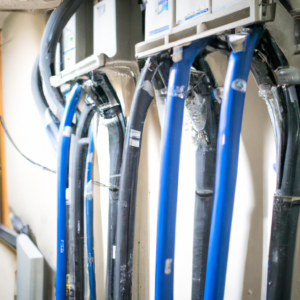Digging beneath the surface can reveal more than what meets the eye. It uncovers a complex network of underground utilities, pipelines, and cables that are critical for modern infrastructure. However, working on or near these underground assets without proper knowledge and caution can lead to accidents, service disruptions, and costly repairs. This is where underground service locators come into play. In this article, we will delve into the importance of underground service locators and how they ensure safety and efficiency in construction projects.
Definition of Underground Service Locators

Underground service locators
Understanding Underground Service Locators
Before we dive deeper, let’s define what underground service locators are. Underground service locators are professionals who specialize in locating and identifying underground utilities such as electrical cables, gas pipelines, water mains, and telecommunication lines. They utilize advanced technologies and specialized equipment to detect and map the precise location of these utilities, helping construction crews avoid accidental damage during excavation.
Importance of Underground Service Locators
Ensuring Safety and Avoiding Disruptions
Underground service locators play a crucial role in ensuring safety and preventing disruptions to essential services. By accurately marking the location of underground utilities, they enable construction crews to work with confidence, minimizing the risk of accidentally damaging critical infrastructure. This prevents service outages, reduces the likelihood of injuries, and saves both time and money on repairs.
Common Methods Used by Underground Service Locators
Techniques for Locating Underground Utilities
Underground service locators employ various methods to detect and locate underground utilities. Some common techniques include:
- Electromagnetic Induction: This method uses electromagnetic signals to detect and map metallic underground utilities. By inducing an electromagnetic field and measuring the response, locators can identify the presence and approximate location of metallic pipes or cables.
- Ground Penetrating Radar (GPR): GPR uses high-frequency radio waves to penetrate the ground and create a detailed subsurface map. It can detect changes in material properties, allowing locators to identify underground structures and utilities.
- Radio Detection and Ranging (RADAR): RADAR-based locators use radio waves to detect and locate underground utilities. These devices emit signals that bounce back when they encounter an underground object, providing locators with information about its presence and location.
Benefits of Hiring Professional Underground Service Locators
Advantages of Hiring Professionals
Hiring professional underground service locators offers numerous benefits, including:
- Accurate Utility Mapping: Professionals have the expertise and equipment to accurately map underground utilities, providing precise information about their depth, size, and layout.
- Time and Cost Savings: By avoiding accidental utility damage, construction projects can proceed smoothly without delays or costly repairs. This saves time and money in the long run.
- Compliance with Regulations: Professional locators are well-versed in local regulations and standards. By adhering to these guidelines, they ensure that projects meet safety requirements and avoid legal complications.
Factors to Consider When Choosing an Underground Service Locator
Selecting the Right Underground Service Locator
When selecting an underground service locator, consider the following factors:
- Experience and Expertise: Look for locators with a proven track record and specialized knowledge in underground utility locating.
- Technology and Equipment: Ensure that the locator uses modern technology and reliable equipment to provide accurate results.
- Certification and Insurance: Check if the locator is certified and adequately insured, providing you with peace of mind in case of any unforeseen incidents.
Tips for Efficient Use of Underground Service Locators
Maximizing the Benefits of Locating Services Underground
To maximize the benefits of underground service locators, consider the following tips:
- Early Planning: Involve locators in the project’s planning phase to ensure accurate utility mapping and minimize surprises during construction.
- Communication and Collaboration: Maintain open lines of communication between the locator, construction crew, and other stakeholders to ensure a smooth workflow.
- Regular Updates: Continuously update the utility maps as the project progresses, taking into account any changes or additions to the underground infrastructure.
Challenges Faced by Underground Service Locators
Overcoming Obstacles in Utility Locating
Despite their vital role, underground service locators face several challenges in their work, including:
- Inaccurate Utility Records: Outdated or incomplete utility records can lead to discrepancies and make the locating process more challenging.
- Complex Urban Environments: Locating utilities in densely populated urban areas with intricate underground networks can be particularly demanding.
- Depth and Access Limitations: Some utilities may be located at significant depths or in areas with limited accessibility, making their detection more difficult.
Safety Measures for Underground Service Locators
Ensuring Safety in Utility Locating
Safety is paramount for underground service locators. Some essential safety measures include:
- Personal Protective Equipment (PPE): Locators should wear appropriate PPE, including high-visibility clothing, hard hats, safety boots, and gloves.
- Training and Certification: Adequate training and certification ensure that locators are well-equipped to handle various scenarios and follow industry best practices.
- Site Risk Assessment: Conducting a thorough risk assessment before commencing work helps identify potential hazards and implement appropriate safety measures.
Future Trends in Underground Service Locating Technology
Advancements on the Horizon
The field of underground service locating continues to evolve. Some emerging trends include:
- Advanced Data Integration: Integrating utility data with geographic information systems (GIS) and other mapping technologies enables more comprehensive and intuitive underground infrastructure management.
- Artificial Intelligence and Machine Learning: These technologies can enhance the accuracy and efficiency of utility locating by analyzing vast amounts of data and identifying patterns.
- Drone-Based Utility Mapping: Utilizing drones equipped with specialized sensors and cameras can provide aerial views of underground infrastructure, aiding in utility detection and mapping.
Conclusion
In conclusion, underground service locators play a vital role in ensuring safety, efficiency, and cost-effectiveness in construction projects. By employing sophisticated technologies and expertise, these professionals enable accurate utility mapping and help prevent accidental damage to critical infrastructure. As technology continues to advance, the future holds even greater potential for improving the effectiveness and precision of underground service locating.
